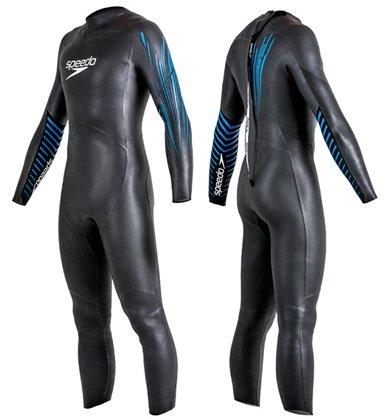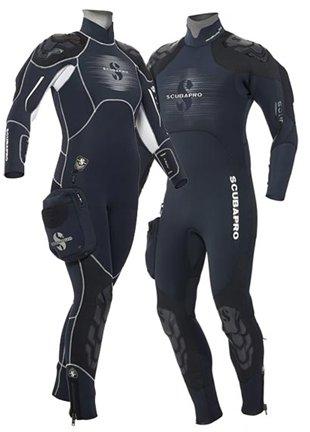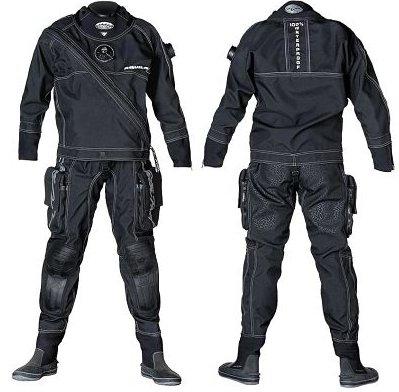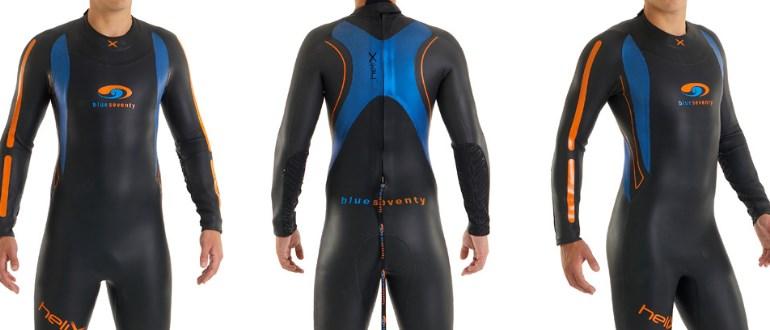A wetsuit can be required by anyone who prefers water recreation or training in it. Without it, it is difficult to hold out in the sea or river for more than an hour, even if the water is warm. As a result of a large temperature difference, hypothermia begins, and equipment allows you to protect the body from this phenomenon. In addition, the swimmer will be protected from injury and can add speed. Before buying, you need to know how to choose a wetsuit so as not to purchase the wrong product that will not fit in size or for a certain type of activity.
Content
Types of wetsuits
Before considering the specifics of swimming equipment, you need to understand how to choose the right wetsuit according to the type of product.
Wet

This type of suit is the cheapest, but also one of the best in terms of comfort. The models are created using an unusual "heating" method. With the help of a zipper, as well as some unsealed parts of the equipment, up to 1 liter of water penetrates inside, which does not flow out of the suit. This makes it possible to warm it up with the swimmer's body and to make a certain layer between the skin and the wetsuit itself, which helps to reduce heat loss.
Often the thickness of this type will be 1-5 mm, therefore, when swimming in the range of 16-24 degrees of heat, a person will be comfortable. In addition, there are very thin models of wet suits on sale, which are made of lycra, but they are recommended for use in warm water of 25-30 degrees. They are no longer used for isolation, but as protection against jellyfish, water scratches and more.
Wet models are made from a neoprene casing, which can be supplemented with thermal padding or nylon. Due to the use of auxiliary material, a little strength is added, and insulating qualities are also increased, while all human movements remain free, without constraint.
Pros:
- Large selection of different models.
- Low weight.
- High degree of comfort.
- Excellent elasticity of the material.
- Affordable pricing policy.
Minuses:
- Thin materials, as a result of which the suit can be easily ripped and damaged, and heat retention will be worse.
- Long sleeves and pants are difficult to wear, so swimmers need to apply a specialized gel to their bodies.
Semi-dry

This is the middle between a dry and wet type of wetsuit. In the manufacture, a rather dense material is used - neoprene, which allows you to keep body heat well. The models have seals, as well as zippers that do not get wet. Water can get under the equipment, but its volume will be up to 250 ml.
For the semi-dry type, it is customary to use materials 2-7 mm in thickness, therefore it is recommended to use them for rivers and seas at a temperature of 10-20 degrees Celsius. Often, products are made from a pair of elements - a jacket and overalls, but manufacturers provide a helmet, boots, and other protective elements in the kit.
Pros:
- They make it possible to maintain and regulate the temperature well under water.
- Convenient models to use with an optimal level of comfort.
- Low weight with high strength.
- The materials have practically no effect on the swimmer's movements.
- Provide excellent protection for the body from possible damage.
The main disadvantage is the time spent under water - no more than 2 hours.
Dry

Such models are completely different from wet ones, since they are characterized by tightness, do not allow water to penetrate inside. The main plus is the maximum retention of heat that a person emits. This is achieved by stitching all parts of the suit, including a helmet, boots, seals, they serve to seal the cuffs on the arms, legs and neck. In addition, manufacturers provide protective thermal underwear in the kit, there is a gas-tight zipper.
In the middle of such a product there is an air valve, which provides more comfort if the swimmer needs to use heavy equipment for work. The materials of the wetsuit are quite dense, 5-15 mm thick. While swimming, a person will feel the stiffness of the movements, which are most felt at depth. The main advantage of dry options is the ability to swim in water less than 0 degrees.
The products are quite expensive, so they are used more often by professionals, not amateurs. Due to their high density, it is recommended to use them for specific tasks, when the swimmer does not need frequent maneuvers and movements. It is dry types of overalls that are used for prolonged stay under water.
Pros:
- Complete tightness of models.
- The ability to use in addition clothing or thermal underwear under the suit.
- It is almost impossible to freeze on land or in water.
- High strength of materials.
- They give the opportunity to be in the water for the maximum time.
Minuses:
- While swimming, movement will be constrained.
- High cost of goods.
Top wetsuit manufacturers
The wetsuit does not belong to cheap equipment, so it is bought for several seasons, years. In this case, it is important to understand which wetsuit to choose by manufacturer. It would be wrong and a pity to spend a lot of money on equipment of mediocre quality, and throw it away after a few months.
It is best to immediately select a product from a reputable manufacturer that offers quality and durable products for any type of water sports. In this case, you don't have to think that the suit will start leaking or there will be other defects. Among the most popular and high-quality companies offering wetsuits are:
- Marlin Skiff;
- Scubapro;
- Mystic;
- Omer.
In any case, before buying, you need to understand the basic rules of choice that will help increase the degree of comfort for the swimmer, his safety.
Wetsuit selection options
When figuring out how to choose a wetsuit for swimming, you need to understand that such a product will not necessarily be a solid jumpsuit that completely covers the body. On sale there are options in the form of a jacket or pants with shortened sizes, as well as individual items. In addition, maybe a helmet with high elasticity, under which water does not penetrate. It attaches to the throat cuff. The choice of model directly depends on the temperature of the water, the period when the equipment is planned to be used.
The main task of such a product is to preserve the heat of the human body, as well as protect it from the sun, winds, and skin injuries. Some options from well-known manufacturers have been improved as much as possible, so they allow you to swim faster, reducing the resistance of oncoming streams.
The size
For many people, the biggest challenge is how to choose the size of a wetsuit. If everything is done correctly, then the fit of the model on the body and the performance of the main tasks will be as correct as possible. The selection is important to carry out strictly in size, and for this you need to know the height, chest, waist and hips.
If the purchase is carried out on the Internet, then you will also need to measure the size of the biceps, wrist, upper thigh, knee and calf. To accurately select the size, you can still measure the shoulders, back length. All received data is checked in the manufacturer's table. It is very important to remember that each brand is characterized by its own size. The permissible rate of discrepancy in size is up to 2 cm.
It is much better if there is an opportunity to try on the product before buying it. A prerequisite is a tight fit (except dry), without squeezing parts of the body. There should be no strong pressure in the throat and chest area. To check, you should stay in the product for a few minutes. Free sensations can be in the armpits, as well as in the lower back.
Material
Almost all wetsuits in stores are made from neoprene. This material is a regular foam rubber which is very light in weight. It is characterized by good resistance to pressure under water, which gives optimal protection of the body from the cold. Floating to the surface, the material recovers after being compressed in volume.
Manufacturers use 2 types of neoprene, which can be foamed with a gas or chemically created pores in it, so the models will be cheaper and of lower quality. In addition, there are many subspecies of raw materials.
When choosing a material, any swimmer needs to understand the following features:
- Pure neoprene is characterized by minimal weight, excellent elasticity and good body protection from low temperatures. The main disadvantage is susceptibility to sunlight and damage, so the durability is small. Raw materials are often used for seals in the form of inserts.
- Dubbed is a strong raw material with a long service life and excellent strength. From the first type, it is 20% better in terms of heat retention.
- "Open pore" is a special material that has pores inside that stick to the body. This solution helps to reduce the circulation of fluid under the overalls, and also improves the insulation properties.
Dry overalls can be made from slightly different raw materials, which will be more elastic:
- Trilaminate is a blend of nylon and rubber. Wetsuits are flexible, they perfectly protect the human body from the ingress of liquid, but the insulation from the cold is small, so when choosing, you should immediately buy thermal underwear.
- Pressed neoprene is one of the best materials for protection from the cold, but the material is dense, so movement will be constrained, in addition, the raw materials are short-lived.
- Crushed neoprene - the best protection against cold, with a long service life and strength.
- Super stretch - the material is characterized by better elasticity and also remembers the shape of the wearer's body. It is often used in the form of inserts in the armpits and in the shoulders, which helps to achieve free movement.
Shell thickness
The density of equipment will directly depend on the time and duration of the voyage. In this case, the buyer needs to look for the middle option, because the greater the thickness, the more constrained the movement, but improved heat retention is provided. Manufacturers offer the following casings:
- 1-2mm is a good choice for those looking for maximum flexibility and lightweight protection from the cold. It is recommended to use the shell for swimming in water of 27 degrees or more.
- 3 mm - suitable for swimming in rivers and seas at 20 degrees.
- 5-6 mm - models are great for cool waters, which will be about 15 degrees.
- 7 mm - the thickness will allow you to float at +12 degrees.
- 9 mm - it is recommended to use this density if you need to work in water up to +10 degrees.
The specified parameters are applicable for wet and semi-dry type of overalls, but dry options can be operated even in frost. The data described are only recommended, because each swimmer tolerates the cold differently, so you need to choose from your own physiology.
To achieve maximum thermal insulation and maintain flexibility, it is best to buy combination types where manufacturers use different material thicknesses for 1 suit. In this case, thinner raw materials are used in all areas of the bends.
Cut
The cut is selected taking into account the operating conditions of the wetsuit and the type of activity:
- In the warm season, without significant obstacles in the water that can cause mechanical damage to the body, a shortened shorty, where open knees and elbows are made, will suffice.
- For cold waters or deep underwater diving with reefs, use monocoimals, a combination type that has long pants and sleeves.
Lightning will be of no less importance. If it is long, then it will be easier to button up the jumpsuit, otherwise it must be put on over the head. You should also look at the placement of the clasp. The most comfortable place is the front, but on the back they will not bulge and improve the speed of movement. The worst thing is to use a zipper on the shoulder, because when you swim quickly and move your hands, it will interfere and irritate the skin.
Type of seams
By the seam, you can understand how high-quality the product is, what its average strength and flexibility are. Many manufacturers give the following variations to choose from:
- Zigzag seam. Its disadvantage is the inability to withstand peak loads, so it is allowed to be present only in places that are not stretched. Jumpsuits made entirely to this cut are not recommended for purchase.
- Mauser. It is characterized by high quality but mediocre elasticity. Excellent performance will be achieved with the right size.
An equally important point is the method of fastening all elements of the wetsuit. Cheap options are made simply, the main parts are folded with each other, the top is sewn with an overlock, which is not characterized by high strength and flexibility. In addition, the person will constantly feel unpleasant sensations, because the line is convex.
Flatlock is a flat seam with optimal comfort for the swimmer. Before starting to connect the elements, all places are joined. This type is used only in wet or semi-dry models, since punctures remain at the fixation points through which liquid penetrates.
Blindstitch - the seam is also called blind. The suits are airtight, durable and elastic. All elements are glued and then sewn. During manufacture, the needle does not make holes in the shell, but fixes it with a weave.
Additional sealing can improve the quality of joints that are really weak. For this, gluing the joints with a special tape is used, but rubber treatment is the best option.
Which wetsuit to choose
There are some simple tips from the masters that will make the choice easier for anyone:
- For divers, it is recommended to buy semi-dry or wet models, with materials up to 5 mm in thickness and long arms and pants. It is best if the inside of the material is open-pored, and the outside is completely smooth. Chest guides are also suitable to reduce drag. For more freedom of swimming, it is recommended to buy models with armpit and shoulder inserts.
- For spearfishing, overalls made of a pair of components or monosuits are suitable. Boots and a helmet should be a mandatory element. It is not recommended to choose goods with zippers, but if financial possibilities permit, then it is allowed to purchase goods with a gas-tight fastener. The semi-dry type with pores on the inside and a perfect fit is best suited. The material should be 5-7 mm thick, but the indicator always depends on the swimming conditions.
- For those people who will buy equipment just for summer swimming and entertainment, such as jet skiing, rides or surfing, the wet type is the best choice. The thickness of the material should be 3 mm. Combined products can also be used. When choosing, a short sleeve or its complete absence is allowed, which helps to make the arms completely mobile. Pants in this case should be as long as possible with auxiliary parts on the knees for protection, especially if the wetsuit will be used by beginners.
- Researchers, cavers and other people who have to spend hours in the water at any time of the year should give preference to models with 7-9 mm material. In addition, it is important that the product is complete.
The cost of products directly depends on the manufacturer and the specific type. For example, short wet models in stores are presented in the range of 1200-17000 rubles. If the option is with long sleeves and pants, then the initial price will be about 6 thousand rubles. Semi-dry options cost about 5-20 thousand rubles. for shortened models and 7-28 thousand rubles. for the standard ones. To hunt under water, the buyer needs to be ready to pay 2.5-26 thousand rubles. The most expensive dry species, which start at 10 thousand rubles. and the end is 140 thousand rubles.
Care and storage
There are a few rules to help you keep your swimming gear as good as possible:
- Overalls are not allowed to be machine washed or ironed.
- Do not dry in the open sun or just leave suits on it, this will quickly deteriorate the main material.
After application, you need to do a light rinse to remove salt, sand or dirt, hang equipment in the wind in the shady side, and after drying one side, make a turn to the other.
If there is a smell from a suit, then rinse in water and soap, and rinse thoroughly after washing. It is forbidden to use powder and other detergents that are not specifically designed for processing such a product. Separate care solutions can be found on sale.
Storage is recommended to be carried out on a hanger or folded, which will exclude stretching. If the product is torn, then the repair is carried out using rubber or specialized glue. In case of seams divergence, it is recommended to return the product under warranty or replace it with a new one.



